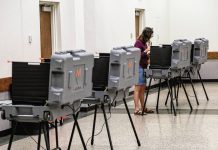Columbus sanitation crews picked up more than 35 tons of recyclable materials from residents’ new green-lidded toters during the first week of citywide curbside recycling.
That pace would more than double the city’s original recycling volume goal of 873.6 tons per year. With the first week’s recycling results in, the city has raised that goal to 2,080 tons annually.
The forecast originally was based on 4,800 participants, which the city increased to 8,000 users.
City officials said the program, which began the second week of its first two-week cycle Monday, is going smoothly and shows signs of good things to come.
[sc:text-divider text-divider-title=”Story continues below gallery” ]
‘Long time coming’
Residents have been enthusiastic about the program, which “has been a long time coming,” Mayor Kristen Brown said.
Bryan Burton, who manages the city garage, said the amount of material the truck picked up required more than one drop-off to the transfer site on some days.
Sanitation crews picked up about 71,000 pounds of recyclable materials last week from 2,658 houses, among more than 7,000 households that signed up for the program. Residents were assigned to “A” or “B” routes, and the city’s recycling truck, covered in its own unique design, stopped at “A” houses last week and started on “B” residences beginning Monday.
Happy customers
Sharon Wright, a westside resident, was one of the first 500 or so residents to have her recycling picked up. After serving the city garage as its first customer Feb. 2 following a ribbon-cutting ceremony, the recycling truck headed out to service most city neighborhoods west of Terrace Lake Road.
Wright and her husband, who live on the outer edge of Tipton Lakes, filled their large toter to the brim after getting it a few weeks before the program started, she said.
“When I first saw it, I thought, ‘Oh my gosh that’s big,’” Wright said of the 96-gallon toter. “I didn’t realize how much we use that was recyclable.”
Thomas Smith, who lives in downtown Columbus, said his toter was at least ¾ full when he set it out for crews to pick up Tuesday morning.
Smith said he and his family have recycled before. They took newspapers to St. Peter’s Lutheran Church, and the household utilized a curbside program that Rumpke Waste Inc. offered while it lasted.
If his family can keep the recycling toter that full going forward, Smith estimated it would reduce their bags of garbage by about one per week.
Recycling also cut down the amount of material in Wright’s garbage toter, which she said had “hardly anything in it at all.”
That illustrates how the curbside recycling helps keep the landfill from filling up more quickly, a clear benefit of the program, Wright said.
The city sent about 16,000 tons of waste to the Bartholomew County Landfill last year, most of which was from the city’s 16,000 residential sanitation customers. It has sent an average of 15,452 tons to the landfill annually during the past five years.
Brown said the city’s revised recycling volume estimates is for an average of 20 pounds per toter during each two-week pickup cycle.
Some areas had less material per toter than others, but the city as a whole averaged nearly 26 pounds per recycling toter, according to numbers the mayor provided Friday.
Nearly all that material has been free of items that have to be picked out manually because they can’t be recycled, Burton said.
He said he got a text from the city’s main contact at Ray’s Trash Service — the company the city hired to take, sort and sell all the recyclable materials — when the first load from the transfer station hit the sorting lines up in Indianapolis, and they were happy with how clean the material was.
Ray’s is working to lease property with an existing building or an open lot where it can build to set up a more permanent transfer station, Brown said. Meanwhile, the sanitation crew is dumping out loads onto a floor to get scoops into containers and hauled to Indianapolis.
The city plans some educational efforts, including reminding people what materials can go in the toters and when it’s necessary to separate two recyclable materials that are packaged together, Brown said.
Burton said that, based on what crews saw last week, people should know not to bag materials and to make sure toters are at least 2 to 3 feet apart. More space is better if people’s driveways are wide enough, he said. Residents with narrower driveways should put toters a minimum of 1 foot apart, making it easier for automated pickup, he said.
City residents already have said they enjoy the convenience of putting all their recyclables into one toter instead of sorting them to take to sites all over the city, she said.
“It really is so easy to do,” Wright said. “Instead of throwing it in the trash, you throw it in the other one. It couldn’t be more convenient.”
[sc:pullout-title pullout-title=”How to sign up for curbside recycling” ][sc:pullout-text-begin]
The city’s curbside recycling program is an ongoing program with no deadline for residents to sign up.
People can sign up at any time by going to columbus.in.gov/columbus-recycles/columbus-recycles-sign-up/. The application requires some basic information, such as name, address and a contact number. People also can elect to receive email updates or select a 48- or 64-gallon toter.
[sc:pullout-text-end][sc:pullout-title pullout-title=”Have questions?” ][sc:pullout-text-begin]
Residents with questions about the curbside recycling program can visit columbus.in.gov/columbus-recycles/frequently-asked-questions or call the city garage at 812-376-2509.
[sc:pullout-text-end][sc:pullout-title pullout-title=”Recycling tonnage the first week” ][sc:pullout-text-begin]
Feb. 2: 7.33
Feb. 3: 3.73
Feb. 4: 11.07
Feb. 5: 7.29
Feb. 6: 6.18
[sc:pullout-text-end][sc:pullout-title pullout-title=”Recycling do’s and don’ts” ][sc:pullout-text-begin]
DO recycle:
- Glass bottles and jars
- Plastics No. 1 through No. 7
- Metal cans
- Aluminum foil and aluminum foil pans
- Cardboard, newspaper and magazines
- Paper food containers
- Paper
DON’T recycle:
- Plastic bags or trash bags
- Plastic food wrappers
- Plastics without numbers
- Greasy food containers
- Food or liquid waste
- Yard waste
- Construction debris or scrap material
- Hazardous waste
- Electronics, cables or batteries
- Diapers, tissue or biohazardous waste
- Light bulbs
- Ceramics, dishes or mirrors
- Hoses, toys, clothes, shoes, tools, plastic straws, to-go lids
- Holiday decorations
- Styrofoam
- Envelopes lined with bubble wrap, other shipping materials
[sc:pullout-text-end]




